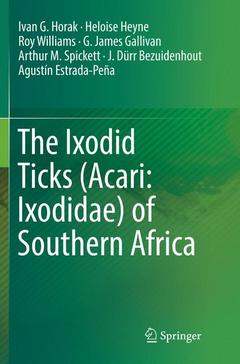Description
The Ixodid Ticks (Acari: Ixodidae) of Southern Africa, Softcover reprint of the original 1st ed. 2018
Authors: Horak Ivan G., Heyne Heloise, Williams Roy, Gallivan G. James, Spickett Arthur M., Bezuidenhout J. Dürr, Estrada-Peña Agustín
Language: English
Subjects for The Ixodid Ticks (Acari: Ixodidae) of Southern Africa:
Approximative price 174.06 €
In Print (Delivery period: 15 days).
Add to cartPublication date: 02-2019
676 p. · 15.5x23.5 cm · Paperback
242.64 €
In Print (Delivery period: 15 days).
Add to cartPublication date: 03-2018
Support: Print on demand
Description
/li>Contents
/li>Biography
/li>Comment
/li>
CHAPTER 1
Introduction
CHAPTER 2
History
2.1 South Africa
2.2 Namibia
2.3 Botswana
2.4 Swaziland
2.5 Lesotho
2.6 Maputo Province
CHAPTER 3
Sources of Information and Methods
3.1 Southern Africa: Countries, Topography, Climate and Biomes
3.1.1 Countries
3.1.2 Topography
3.1.3 Temperature and rainfall
3.1.4 Biomes
3.2 Nomenclature
3.2.1 Ticks
3.2.2 Hosts
3.3 Descriptions
3.3.1 Taxonomy
3.3.2 Size
3.3.3 Male to female ratio
3.4 Distribution
3.4.1 South African Tick Survey
3.4.2 Other surveys
3.4.3 Regional distribution
3.5 Tick Collection
3.5.1 Tick collection from live animals
3.5.2 Tick collection from dead animals
3.5.3 Vegetation
3.6 Tick/Host and Host/Tick Lists
3.7 Host Specificity
3.8 Seasonal Abundance
3.9 Life Cycles
3.10 Tick-Borne Diseases
3.11 References
CHAPTER 4
The Genus Amblyomma
CHAPTER 5
The Genus Haemaphysalis
CHAPTER 6
The Genus Hyalomma
CHAPTER 7
The Genus Ixodes
CHAPTER 8
The Genus Rhipicephalus
CHAPTER 9
Ticks belonging to other Genera
CHAPTER 10
Hosts and Host and Vegetation Tick Lists
Hosts
Domestic animals
Humans
Wildlife
Host/Tick Lists
South Africa
Namibia
Botswana
Swaziland
Lesotho
Maputo Province
CHAPTER 11
Tick-Borne Diseases
Animals
Humans
Ivan G. Horak is an Emeritus Professor in the Department of Veterinary Tropical Diseases, Faculty of Veterinary Science, University of Pretoria, Onderstepoort, South Africa.
Heloise Heyne is a Senior Technician and the Curator of the Gertrud Theiler Tick Museum, in the section Epidemiology, Parasites & Vectors, Agricultural Research Council–Onderstepoort Veterinary Institute, Onderstepoort, South Africa.
G. James Gallivan Ottawa, Ontario, Canada. Formerly Department of Biology, University of Swaziland, P/B Kwaluseni, Swaziland.
Roy Williams is a Senior Researcher in the section Epidemiology, Agricultural Research Council–Onderstepoort Veterinary Institute, Onderstepoort, South Africa.
Arthur M. Spickett is a retired Senior Researcher in the section Epidemiology, Parasites & Vectors at the Agricultural Research Council-Onderstepoort Veterinary Institute, Onderstepoort, South Africa.
J. Dürr Bezuidenhout is a retired Veterinary Researcher and Deputy Director of the Agricultural Research Council-Onderstepoort Veterinary Institute, Onderstepoort, South Africa.
Agustín Estrada-Peña is a Professor in the Department of Parasitology, Faculty of Veterinary Medicine, University of Zaragoza, Zaragoza, Spain.
Comprehensive work on the ticks of Southern Africa, their morphology, distributions, hosts and life cycles
Comprehensive tick/host tables and host/tick tables populated with numbers of hosts infested and most tables with total numbers of ticks collected
Tick-borne diseases and tick-transmitted toxins that affect animals and humans are mentioned in the text and their modes of transmission summarized in tabular format with accompanying references




